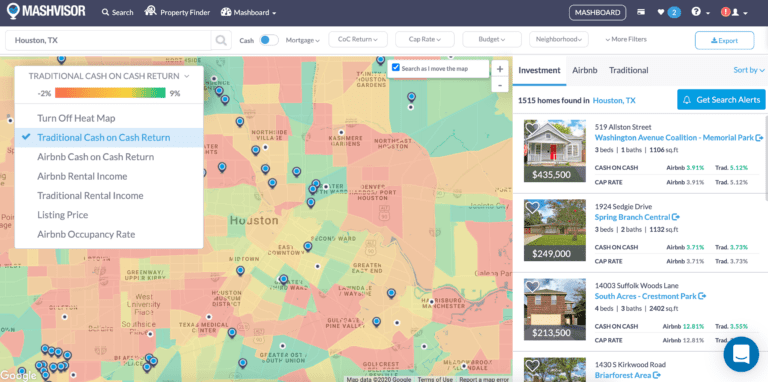What Is a Good Gross Rent Multiplier?
How to Rent Your House: The 8-Step Guide to Success
Diving into the world of real estate investing can be very daunting, especially for a beginner real estate investor. One of the reasons this is so is because of the vast diversity of investment properties to choose from. However, by using the right strategies and tools in your investment property search, you can find a lucrative investment. One of the ways that real estate investors use to identify potentially profitable investment properties for sale is by figuring out the gross rent multiplier for different properties.
Using gross rent multiplier is an easy way for real estate investors to quickly filter through multiple investment options. In this article, we’ll take an in-depth look at what the gross rent multiplier is, how investors should use it, and answer the question, ”What is a good gross rent multiplier?”
Related: 7 Real Estate Numbers Every Investor Needs for Analyzing Investments
What Is a Gross Rent Multiplier?
Gross rent multiplier (GRM) is the ratio of the price or fair market value of a rental property to its gross rent. The gross rent multiplier formula is as follows:
Gross Rent Multiplier = Property Price / Gross Annual Rent
As you can see from the GRM formula, it doesn’t factor in the rental property’s operating expenses or debts used to purchase the property. As such, GRM is only a quick screening tool to determine which properties are worthy of further analysis rather than as a definitive profitability indicator.
Of course, this assumes that you know the estimated gross rent of the property. If not, you’ll need to conduct a rental market analysis to determine the average asking rents of comparable properties in the area.
How Is the Gross Rent Multiplier Used?
1. Narrowing Your Property Search
One of the most crucial skills a real estate investor needs to have is to be able to quickly gauge the potential profitability of an investment property to decide whether to allocate more time and resources to conducting further investment property analysis.
When looking for an investment property to purchase, savvy investors normally sift through numerous investment properties for sale and consider a multitude of factors before choosing the property to buy. However, it’s hard and time-consuming to compare multiple investment properties when you have to take into account property expenses and other property features.
GRM is used to quickly compare similar properties to determine those that warrant further investigation using more precise property analysis methods. This way, you will be able to save much of your time and money when searching for an investment property. Rather than digging into the financials of every single investment property for sale you come across, you quickly find the GRM and decide at first glance whether to evaluate a rental property in detail or just consider other properties.
The GRM formula is also easy to use even for beginner real estate investors. Unlike other complicated formulas, anyone can learn how to calculate gross rent multiplier and use it with little risk of making mistakes. Keep in mind that GRM in real estate is only for narrowing down your investment property search and is not meant to substitute investment property analysis.
2. Property Valuation

The gross rent multiplier can help you estimate a property’s value.
Apart from using GRM as a starting point when analyzing real estate deals, it can also be used for estimating the value of an income property if it’s not known. If you know the gross annual rental income of the property and the average GRM of comparable properties in the area, you can multiply the two to determine the estimated property value. While this property valuation method is not accurate, it can provide a workable estimate that you can use to compare multiple properties.
When valuing a property, the GRM formula can be flipped as follows:
Property Value = GRM x Gross Annual Rent
Again, when valuing a property using the GRM, it should be used as a rough guide and not as the actual value of the property. You would need to assess comparable sales (real estate comps) to determine a more accurate fair market value.
Related: Comparative Market Analysis for Beginner Real Estate Investors
How to Make an Offer on a House That Is Overpriced
3. Estimating Expected Rental Income
If you know the GRM and fair market value of a rental property, you can twist the GRM formula to estimate the expected gross rent.
Gross Rent = Property Price/GRM
If the actual annual rental income greatly exceeds this estimate, it’s likely a profitable rental property.
4. Lenders Use GRM to Assess a Property’s Suitability for a Loan
Real estate investors are not the only ones who use the gross rent multiplier. Lenders also use this metric to quickly assess whether or not a property would enable the property investor to effectively pay back their loan.
Some real estate investors also use gross rent multiplier to estimate how long it would take to pay off an investment property. However, this isn’t usually accurate because this period of time is driven by other factors such as rental expenses which reduce the amount of cash available for amortization.
What Is a Good Gross Rent Multiplier?
All other things being constant, a real estate investor assessing multiple investment opportunities would want to focus their investment property analysis efforts on properties with a good gross rent multiplier. But what is a good gross rent multiplier? Do you want a high or low gross rent multiplier?
Well, what is considered a good gross rent multiplier varies depending on a number of factors such as location, type of property, etc. For instance, Class B and Class C rental properties located in suburban markets will often have a lower GRM than Class A rental properties in urban markets. This number will also decrease gradually as the real estate cycle extends and property prices change.
However, in general terms, the lower the GRM, the more potentially profitable the investment property is. The most important thing to be aware of is that you should compare apples to apples when assessing GRM. Use GRM to evaluate similar investment properties in the same housing market.
Conducting In-Depth Investment Property Analysis
As discussed, the gross rent multiplier is primarily used as an initial screening tool when looking at multiple investment opportunities. This is because the GRM formula doesn’t account for operating expenses such as general maintenance, property taxes, insurance, property management, utilities, and vacancies. Hence, a rental property may seem more valuable than it actually is.
While you can determine the gross rent multiplier and see how one investment property compares to others, it does not show the whole picture. Therefore, when you are setting out to find a profitable rental property, it’s imperative that you do more detailed due diligence after selecting properties with a good gross rent multiplier in your initial screen.
Cap rate is one of the key metrics for analyzing a rental property’s return on investment. Unlike the GRM that uses gross rental income, it is based on Net Operating Income (NOI) as a ratio against property price or current market value. Since the cap rate incorporates operating expenses and vacancies, it’s a more superior metric for measuring profitability potential than GRM. If you want to also account for financing costs, you can use the cash on cash return formula.
Related: Cap Rate vs. Gross Rent Multiplier: Advantages and Disadvantages
Using Mashvisor’s Investment Property Calculator
While the 2 ROI metrics are more effective than GRM, they require significantly more time and effort to calculate correctly. It’s hard to accurately determine a rental property’s operating expenses.
Fortunately, with Mashvisor’s investment property calculator, you don’t have to manually search for data and do the ROI calculations. The calculator provides accurate estimates for rental income and rental expenses and allows you to analyze the cap rate and cash on cash return of any investment property for sale in the US housing market in a matter of minutes.
Start Analyzing Investment Properties
The Bottom Line
When evaluating potential income properties for sale in the same market, the gross rent multiplier can be a useful tool for quickly calculating profitability and identifying good opportunities worthy of more sophisticated analysis. However, this metric alone can’t give you a clear picture of the potential return on investment. That’s why you need to use it along with other real estate metrics like cap rate and cash and cash return to precisely determine the profitability of investment properties.
Start Your Investment Property Search!
FinancingGross Rent MultiplierProperty PricesProperty SearchProperty ValuationRental Income
Multifamily Syndication: The Beginner Real Estate Investor’s Guide





Recent Comments